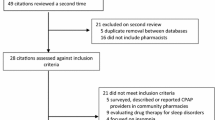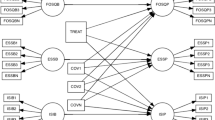Abstract
Background In Australia, certain pharmacies have undertaken a role in the management of the chronic sleep disorder, obstructive sleep apnea. The perspectives of pharmacy staff involved in this niche clinical service have never been formally collated on a national scale. The experiences of Australian pharmacies could provide a template for pharmacies in other health systems to adopt similar roles. Objective To provide an overview of the perspectives of pharmacy staff involved in Continuous Positive Airway Pressure (CPAP) and sleep apnea-related services. Specifically, to describe clinical and structural elements, explore benefits and barriers, investigate viability, and gauge perspectives on future directions. Setting Australian community pharmacies involved in CPAP and sleep apnea-related services. Method Cross-sectional mail survey. A questionnaire designed to meet the study objectives was developed by the researchers and mailed to all pharmacies in Australia providing CPAP services during the period of study recruitment. Pharmacies were identified through the distributor lists of the major CPAP manufacturers and a comprehensive Internet search. Non-responders were contacted in two subsequent recruitment rounds. Main outcome measure Self-reported sleep apnea service specifics. Results A response rate of 55 % was achieved (n = 106 questionnaires valid for data entry). Benefits of providing a CPAP service included meeting patient and community needs, and professional satisfaction. Barriers included the cost of CPAP equipment to patients and lack of time. A majority of pharmacies (71 %) reported the service was financially viable despite most (63 %) not charging a ‘fee for service.’ Respondents expressed the view that CPAP provision should remain a specialist area of practice within the pharmacy profession. Key areas identified for improvement within the service were: (1) Staff training and knowledge (2) Promotion of the service and increasing public awareness (3) Infrastructure and expansion (4) Inter-professional collaboration and communication (5) Patient follow-up. Conclusion The provision of CPAP and sleep apnea-related services can be a viable and rewarding experience for pharmacists. The role may need to remain a specialised area for those willing to invest significantly in the service—in time, staff, resources and finances.



Similar content being viewed by others
Notes
Fisher & Paykel Healthcare Pty Limited®, Melbourne, VIC; Philips Respironics Healthcare®, North Ryde, NSW; and ResMed Ltd®, Bella Vista, NSW.
References
Saini B, Krass I, Smith L, Bosnic-Anticevich S, Armour C. Role of community pharmacists in asthma—Australian research highlighting pathways for future primary care models. Australas Med J. 2011;4:190.
Jarab AS, AlQudah SG, Khdour M, Shamssain M, Mukattash TL. Impact of pharmaceutical care on health outcomes in patients with COPD. Int J Clin Pharm. 2012;34:53–62.
Houle SK, Chuck AW, McAlister FA, Tsuyuki RT. Effect of a pharmacist-managed hypertension program on health system costs: an evaluation of the Study of Cardiovascular Risk Intervention by Pharmacists—Hypertension (SCRIP-HTN). Pharmacotherapy. 2012;32:527–37.
Cranor CW, Bunting BA, Christensen DB. The Asheville Project: long-term clinical and economic outcomes of a community pharmacy diabetes care program. J Am Pharm Assoc. 2003;43:173–84.
Mitchell B, Armour C, Lee M, Song YJ, Stewart K, Peterson G, et al. Diabetes Medication Assistance Service: the pharmacist’s role in supporting patient self-management of type 2 diabetes (T2DM) in Australia. Patient Educ Couns. 2011;83:288–94.
Armour CL, Reddel HK, Lemay KS, Saini B, Smith LD, Bosnic-Anticevich SZ, et al. Feasibility and effectiveness of an evidence-based asthma service in Australian community pharmacies: a pragmatic cluster randomized trial. J Asthma. 2013;50:302–9.
Kryger MH, Roth T, Dement WC. Principles and practice of sleep medicine. 5th ed. Philadelphia: Saunders/Elsevier; 2011.
Young T, Palta M, Dempsey J, Skatrud J, Weber S, Badr S. The occurrence of sleep-disordered breathing among middle-aged adults. N Engl J Med. 1993;328:1230–5.
Wright J, Johns R, Watt I, Melville A, Sheldon T. Health effects of obstructive sleep apnoea and the effectiveness of continuous positive airways pressure: a systematic review of the research evidence. BMJ. 1997;314:851.
Giles TL, Lasserson TJ, Smith B, White J, Wright JJ, Cates CJ. Continuous positive airways pressure for obstructive sleep apnoea in adults. Cochrane Database Syst Rev. 2006;. doi:10.1002/14651858.CD001106.pub3.
Kushida CA, Littner MR, Hirshkowitz M, Morgenthaler TI, Alessi CA, Bailey D, et al. Practice parameters for the use of continuous and bilevel positive airway pressure devices to treat adult patients with sleep-related breathing disorders. Sleep. 2006;29:375–80.
Gay P, Weaver T, Loube D, Iber C, Force PAPT. Evaluation of positive airway pressure treatment for sleep related breathing disorders in adults. Sleep. 2006;29:381.
Weaver TE, Grunstein RR. Adherence to continuous positive airway pressure therapy: the challenge to effective treatment. Proc Am Thorac Soc. 2008;5:173–8.
Pharmaceutical Society of Australia. 2010. Professional Practice Standards. Version 4, June 2010. http://www.psa.org.au/download/standards/professional-practice-standards-v4.pdf. Accessed 5 Feb 2014.
Flemons WW, Douglas NJ, Kuna ST, Rodenstein DO, Wheatley J. Access to diagnosis and treatment of patients with suspected sleep apnea. Am J Respir Crit Care Med. 2004;169:668–72.
Young T, Peppard PE, Taheri S. Excess weight and sleep-disordered breathing. J Appl Physiol. 2005;99:1592–9.
Marshall N, Wong K, Liu P, Cullen S, Knuiman M, Grunstein R. Sleep apnea as an independent risk factor for all-cause mortality: the Busselton health study. Sleep. 2008;31:7.
Chai-Coetzer CL, Antic NA, Rowland LS, Catcheside PG, Esterman A, Reed RL, et al. A simplified model of screening questionnaire and home monitoring for obstructive sleep apnoea in primary care. Thorax. 2011;66:213–9.
Antic NA, Buchan C, Esterman A, Hensley M, Naughton MT, Rowland S, et al. A randomized controlled trial of nurse-led care for symptomatic moderate–severe obstructive sleep apnea. Am J Respir Crit Care Med. 2009;179:501–8.
Chai-Coetzer CL, Antic NA, Rowland LS, Reed RL, Esterman A, Catcheside PG, et al. Primary care vs specialist sleep center management of obstructive sleep apnea and daytime sleepiness and quality of life: a randomized trial. JAMA. 2013;309:997–1004.
Tran A, Fuller J, Wong K, Krass I, Grunstein R, Saini B. The development of a sleep disorder screening program in Australian community pharmacies. Pharm World Sci. 2009;31:473–80.
Kashyap KC, Nissen LM, Smith SS, Douglas JA, Kyle GJ. Can a community pharmacy sleep assessment tool aid the identification of patients at risk of sleep disorders in the community: a pilot study. Integr Pharm Res Pract. 2012;1:3–12.
Hersberger KE, Renggli VP, Nirkko AC, Mathis J, Schwegler K, Bloch KE. Screening for sleep disorders in community pharmacies—evaluation of a campaign in Switzerland. J Clin Pharm Ther. 2006;31:35–41.
Fuller JM, Wong KK, Krass I, Grunstein R, Saini B. Sleep disorders screening, sleep health awareness, and patient follow-up by community pharmacists in Australia. Patient Educ Couns. 2011;83:325–35.
Shoukry G, Wong K, Bartlett D, Saini B. Treatment experience of people with obstructive sleep apnoea seeking continuous positive airways pressure device provision through community pharmacies—a role for pharmacists? Int J Pharm Pract. 2011;19:318–27.
Black J, Saini B, Wong K. The role of pharmacists in improving the management of sleep disorders in the Australian community. Respirology. 2007;12:A24.
Australasian Sleep Association. 2009. Position paper: best practice guidelines for provision of CPAP Therapy. Version 2.2, 14 January 2009. http://www.sleep.org.au/documents/item/66. Accessed 5 Feb 2014.
Hanes CA, Wong KK, Saini B. An overview of service quality of continuous positive airway pressure services in Australian pharmacies. Respirology. 2014;19:85–91.
The Pharmacy Guild of Australia. Quality Care Pharmacy Program Requirements Manual 2011.
The Pharmacy Guild of Australia. 2012 GUILD DIGEST A survey of independent pharmacy operations in Australia (financial year 2010–2011). 2012.
Popescu G, Latham M, Allgar V, Elliott MW. Continuous positive airway pressure for sleep apnoea/hypopnoea syndrome: usefulness of a 2 week trial to identify factors associated with long term use. Thorax. 2001;56:727–33.
Lewis KE, Seale L, Bartle IE, Watkins AJ, Ebden P. Early predictors of CPAP use for the treatment of obstructive sleep apnea. Sleep. 2004;27:134–8.
Lee JK, Grace KA, Taylor AJ. Effect of a pharmacy care program on medication adherence and persistence, blood pressure, and low-density lipoprotein cholesterol: a randomized controlled trial. JAMA. 2006;296:2563–71.
Lee JK, Slack MK, Martin J, Ehrman C, Chisholm-Burns M. Geriatric patient care by US pharmacists in healthcare teams: systematic review and meta-analyses. J Am Geriatr Soc. 2013;61:1119–27.
Tze-Min Ang K, Saini B, Wong K. Sleep health awareness in pharmacy undergraduates and practising community pharmacists. J Clin Pharm Ther. 2008;33:641–52.
Mansoor S, Aslani P, Krass I. Pharmacists’ attitudes and perceived barriers to provision of adherence support in Australia. Int J Clin Pharm. 2013;. doi:10.1007/s11096-013-9840-6:1-9.
Berbatis CG, Sunderland VB, Joyce A, Bulsara M, Mills C. Enhanced pharmacy services, barriers and facilitators in Australia’s community pharmacies: Australia’s National Pharmacy Database Project. Int J Pharm Pract. 2007;15:185–91.
Emmerton LM, Smith L, LeMay KS, Krass I, Saini B, Bosnic-Anticevich SZ, et al. Experiences of community pharmacists involved in the delivery of a specialist asthma service in Australia. BMC Health Serv Res. 2012;12:164.
van Bergen JE, Postma MJ, Peerbooms PG, Spangenberg AC, Tjen-A-Tak J, Bindels PJ. Effectiveness and cost-effectiveness of a pharmacy-based screening programme for Chlamydia trachomatis in a high-risk health centre population in Amsterdam using mailed home-collected urine samples. Int J STD AIDS. 2004;15:797–802.
Snella KA, Canales AE, Irons BK, Sleeper-Irons RB, Villarreal MC, Levi-Derrick VE, et al. Pharmacy-and community-based screenings for diabetes and cardiovascular conditions in high-risk individuals. J Am Pharm Assoc. 2006;46:370–7.
Olenak JL, Calpin M. Establishing a cardiovascular health and wellness program in a community pharmacy: screening for metabolic syndrome. J Am Pharm Assoc. 2009;50:32–6.
Krass I, Mitchell B, Clarke P, Brillant M, Dienaar R, Hughes J, et al. Pharmacy diabetes care program: analysis of two screening methods for undiagnosed type 2 diabetes in Australian community pharmacy. Diabetes Res Clin Pract. 2007;75:339–47.
Goode J-V, Swiger K, Bluml BM. Regional osteoporosis screening, referral, and monitoring program in community pharmacies: findings from Project ImPACT: osteoporosis. J Am Pharm Assoc. 2004;44:152–60.
Anderson C, Thornley T. A pharmacy-based private chlamydia screening programme: results from the first 2 years of screening and treatment. Int J Clin Pharm. 2011;33:88–91.
Young T, Evans L, Finn L, Palta M. Estimation of the clinically diagnosed proportion of sleep apnea syndrome in middle-aged men and women. Sleep. 1997;20:705–6.
Young T, Palta M, Dempsey J, Peppard PE, Nieto FJ, Hla KM. Burden of sleep apnea: rationale, design, and major findings of the Wisconsin Sleep Cohort study. WMJ. 2009;108:246.
Deloitte Access Economics. Re-awakening Australia: The economic cost of sleep disorders in Australia. Sleep Health Foundation, 2010.
U.S. Department of Health and Human Services. Office of Disease Prevention and Health Promotion. Healthy People 2020. http://www.healthypeople.gov/2020/topicsobjectives2020/overview.aspx?topicid=38. Accessed 5 Feb 2014.
Rogers EM. Diffusion of innovations. 4th ed. New York: The Free Press; 1995.
Acknowledgments
C. Hanes is the recipient of scholarships from the Australian Postgraduate Award (APA) and the NHMRC Centre for Integrated Research and Understanding of Sleep (CIRUS), and gratefully acknowledges this support.
Funding
None
Conflicts of interest
The authors declare no potential conflicts of interest with respect to the research, authorship, and/or publication of this article.
Author information
Authors and Affiliations
Corresponding author
Electronic supplementary material
Below is the link to the electronic supplementary material.
Rights and permissions
About this article
Cite this article
Hanes, C.A., Wong, K.K.H. & Saini, B. Clinical services for obstructive sleep apnea patients in pharmacies: the Australian experience. Int J Clin Pharm 36, 460–468 (2014). https://doi.org/10.1007/s11096-014-9926-9
Received:
Accepted:
Published:
Issue Date:
DOI: https://doi.org/10.1007/s11096-014-9926-9




